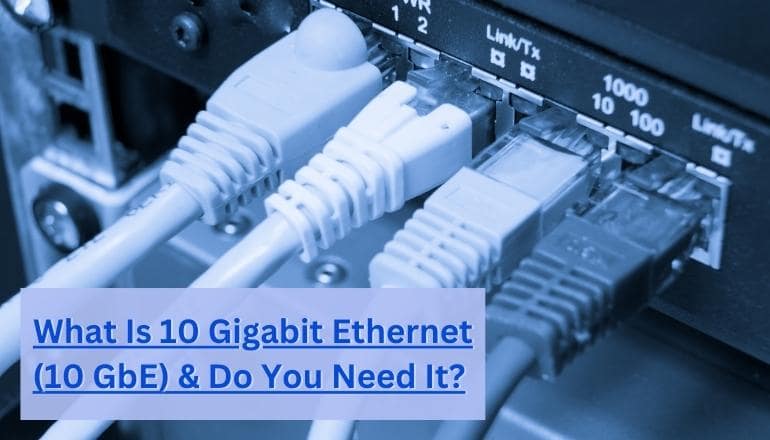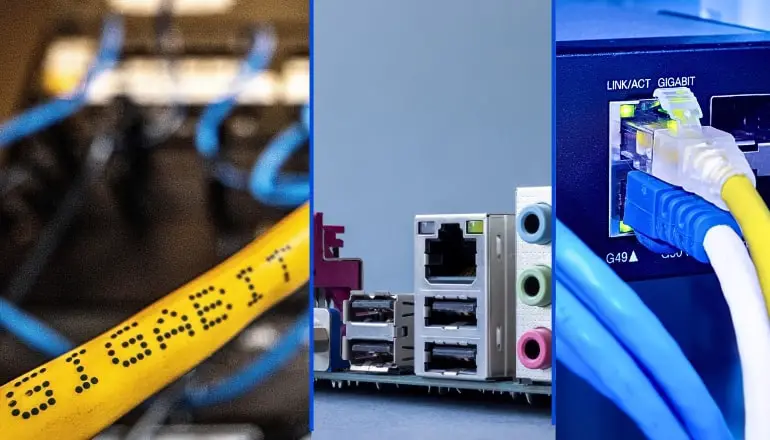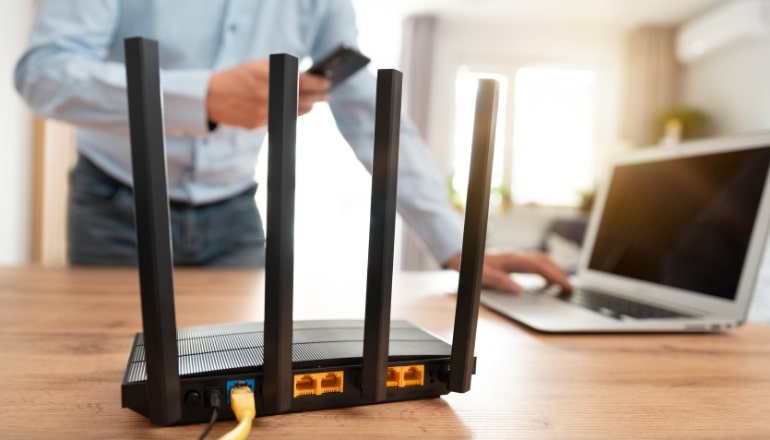What Is 10 Gigabit Ethernet (10 GbE) & Do You Need It?
Do we need to set up a 10 Gigabit network? Are 10 Gbps networks really necessary? What uses does this high-speed network have?
You might have asked yourself these questions or wanted to know the whole story of this type of high-speed network. In this post, I will give the vision of 10 Gigabit Ethernet (10 GbE) and if it’s worth jumping into it.
10 Gigabit Ethernet

So what is 10GbE? This is a technology called 10 Gigabit Ethernet. In technical words, 10G or 10 GigE “is a telecommunications technology that offers data speeds of up to 10 billion bits per second/10 gigabits per second. It is 10 times faster than the traditional Gigabit Ethernet standard (1 Gbps) and can effectively drive any network equipment.
Ethernet trends
The transition of Ethernet from the 1st generation to the 4th generation is as follows.
- 1st generation: 10Mbps (Megabit per second) = 0.125 MB/s (Megabyte per second)
- 2nd generation: Fast Ethernet with 100Mbps (Megabit per second) = 12.5 MB/s (Megabyte per second)
- 3rd generation: Gigabit Ethernet with 1Gbps (Gigabit per second) = 125 MB/s (Megabyte per second)
- 4th generation: 10Gigabit Ethernet (Gigabit per second) = 1.25 GB/s (Gigabyte per second)
The first generation of 10Mbps Ethernet was introduced in the 1980s, and since the 2000s, the transmission capacity has been expanded to 10 times that of the second generation, 100Mbps, and 100 times that of Gigabit Ethernet. After Gigabit Ethernet, 1000BASE-T appeared with the establishment of IEEE 802.3ab in 1998. After that, the specifications of 10Gigabit Ethernet were fixed to IEEE 802.3an and 10GBASE-T in 2006.
Currently, the transition from 10 Gigabit to 25 Gigabit to 100 Gigabit is progressing, and the introduction of 800 Gigabit is being explored in the future.
Applications of 10Gbit Ethernet
10Gigabit Ethernet is used for the following purposes.
- LAN (Local Area Network)
- MAN (Metropolitan Area Network)
- WAN (Wide Area Network)
- SAN (Storage Area Network) etc.
LAN is a network within a limited range, such as within a company. MAN is a communication network that connects cities as the backbone of telecommunications carriers. WAN covers an even wider area. A SAN is a large-scale business network that connects storage devices that store data.
In this way, 10Gbit hardwired Internet is used not only to build large-capacity and comfortable communication environments within companies, but also to build communications infrastructure in cities and regions.
But then, ain’t for homes or small workplaces? Well no! Many home user are using this technology to improve their internet and have a fastest online experience with lowest ping value.
If you have multiple devices connected to the network in your home, such as phones, computers, tablets, and even smart TVs, 10GbE can handle them all without a problem.
With 10GbE, your downloads are much faster, you can watch movies and videos online without stopping mid-play, and your devices are connected efficiently without delays or annoying interruptions. But it is much more than that.
4 Types of 10 Gigabit Ethernet
10 Gigabit Ethernet has some types, differing by a hyphen like in 10GBASE-SR, which indicates the differences and uses of the media used in the devices. Let’s explain the difference.
10GBASE-R
10GBASE-R is a standard for LAN/MAN, and “R” stands for “range.” The transmission speed is 10.3124Gbps, but a 64B/66B encoding method detects and corrects data errors during transmission. Therefore, the effective speed is 10Gbps.
It further divides into:
- 10GBase-SR: This short-range fiber optic technology can transmit data over communication distances of 60 to 300 meters. Here, the initial “S” stands for “Short Range”.
- 10GBase-LR: Here, the initial “L” for “Long Range” enables communication up to 10km using single-mode optical fiber (SMF).
- 10GBase-ER: ER stands for “Extended range.” This extended-range fiber optic technology can transmit data up to 40 kilometers.
10GBASE-W
The “W” in 10GBASE-W indicates that it is compatible with “WAN PHY,” (physical layer implementations), which is standardized in WAN. WAN PHY first appeared in 10Gigabit Ethernet and is a standard to adapt to the SONET/SDH specifications, which are the most popular WAN networks. However, it is not SONET/SDH compliant.
Similar to 10GBASE-R, there are three wavelengths used in 10GBASE-W, and they are 10GBASE-SW (Short Wavelength), 10GBASE-LW (Long Wavelength), and 10GBASE-EW (Extended-Wavelength) from the shortest wavelength.
10GBASE-X
10GBASE-X is a slower standard than others and is mainly used in LAN. 10GBASE-LX4, which uses optical fiber cable, multiplexes signals four times and transmits them. The “4” at the end means that. Gigabit Ethernet generally uses 64B/66B encoding but uses 8b/10b uniquely.
Optical fiber multimode transmission distances are up to 300m, and single-mode transmission distances are up to 10km.
Depending on the cable material, there is also a 10GBASE-CX4 that uses a copper cable. The maximum transmission distance is 15m, used in stacked switching hubs, etc.
10GBASE-T
10GBASE-T uses metal cables such as copper instead of optical fibers. “T” stands for “Twisted pair cable.” There are shielded cables that prevent electromagnetic interference and leakage. Also, unshielded cables are called UTP (Unshielded Twist-Pair). 10GBASE-T is mostly used in communication-related business equipment.
Cables & Devices Compatible with 10 Gigabit Ethernet

It is essential to consider the type of cable you will be using for your 10 Gigabit Ethernet network. Cat.6 Ethernet is the minimum requirement for 10GBASE-T connections, while Cat.6a or Cat.7 cables are recommended for optimal performance.
Cat.6 cables are reasonably affordable and widely available, making them popular for 10 Gigabit Ethernet networks. However, note that these cables have a maximum transmission distance of 55 meters.
Cat.6a or Cat.7 cables are better for longer distances, with maximum transmission distances of up to 100 meters and 250 meters, respectively.
Once you have chosen the cables, the next step is to have a compatible device for your 10 Gigabit Ethernet network. This includes switches, NICs (Network Interface Cards), routers, and high-speed storage like PCIe NVMe SSD with the latest Gen to match high speed when uploading or downloading.
For computers, you must be equipped with a 10GBASE-T NIC or desktop motherboard with a 10 GbE Ethernet port which indicated by blinking lights.
How to Choose Switch for 10Gbe
When choosing a switch, the first thing to decide — is what ports are needed: copper or optical:
- If only copper, you can choose a model with built-in ports 10GBase-T.
- If optical — then with the ports of SFP +. However, some models have most ports — copper and only a few — SFP +.
- And if 10-gigabit ports need only a few, and for most ports, a speed of 1 Gbit / s is enough, then gigabyte switches with additional 10 Gbit / s ports will be a good choice.
- If, on the contrary, 10 Gb / s is not enough, then you can select switches DXS-1210-28T (L2 + Switch with 24 ports 10GBase-T and 4 ports 25GBase-X SFP28) or a series of switches L 3 switches DXS-3610 with 48 10 gigabit ports and 6 ports 100GBase-X QSFP28.
In addition to the speed of the ports, one must also consider the Switch’s soundness: controlled or insisted, with or without routing, etc.
Do I need 10 Gigabit Ethernet (10 GbE) at home?
As I told you above, using 10 GbE is popular in business organizations, especially those that frequently use HD streaming or need to work with large files.
It is also extremely useful for something that can cause congestion on their networks, as many users are connected at the same time. 10 GbE is also often used in large data centers, which are massive, modern, and imposing places where large amounts of information are stored.
But then, do I need 10 GbE at home? If you want a truly fast, almost instant connection, the answer is a resounding YES.
For small home networks, that is, the ones you use at home, 10 GbE can be very useful, for example, if you are a NAS hobbyist or use a lot of cloud tools (like OneDrive, Google Drive) frequently, where the average size of the files is huge to collaborate with other users elsewhere in the world (whether for work or because you have a personal project).
10G helps you prevent the process from becoming slow and tedious. For example, this can be very useful for those working with photography, video, or design files.
But not only that, 10GbE can help you if you are simply a movie lover and are excited to create your own library.
Does it allow you to protect your data in a safer, faster, and more reliable way, for example, to make a backup copy of your entire computer over the network in just a few minutes and without depending on a USB memory?
With the 10 GbE / s network, you can perform all the tasks described above, 10 times faster than with a Gigabit network and 100 times faster than with a 100 Mb/s network.
Lastly, It all depends on your needs and usage patterns. If you frequently work with large files, transfer data over a network, or deal with congested networks like even with previous Gigabit Ethernet with 1Gbps, then 10 GbE is definitely worth looking into.
However, if you don’t require such high speeds or have a small home network where only basic tasks are performed, Gigabit or even 100 Mb/s networks suffice.
WiFi Compatibility

Enjoying the 10 Gbps speeds is not currently possible through WiFi in general. To reach maximum speeds, it is necessary to have an excellent router with WAN and LAN port that supports 10 GbE and a compatible network adapter on the device.
Even though some WiFi standards promise higher speeds, such as WiFi 6, which claims to reach up to 9.6Gbps, the interferences in the network will prevent you from achieving these speeds.
Therefore, it is recommended to opt for mobiles, laptops, or computers with WiFi 6 or 6e to get as close as possible to the speeds offered by 10 GbE. Therefore, a wired connection is always the best choice to take full advantage of the 10 GbE / s network.
